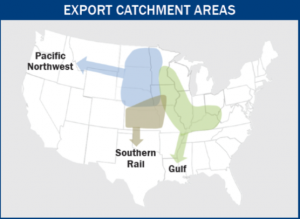Introduction
The 2019/2020 Harvest Report has been designed to help international buyers of corn understand the initial quality of U.S. yellow corn as it enters the marketing channel. This is the ninth annual survey of the quality of the U.S. corn crop at harvest. Nine years of results are showing patterns in the impact of weather and growing conditions on the quality of U.S. corn as it comes out of the field.
Wet weather conditions in April and especially May in key regions of the United States brought an unprecedented beginning to the 2019 growing season. By any metric, this year’s U.S. corn crop was planted extremely late. Using the date when 50% of the corn crop is planted as a benchmark, the 2019 crop was the latest in the past 40 years. While growing conditions were generally favorable across the remainder of the growing season, crop progress never returned to levels of the 5YA following the crop’s late planting. With maturity already delayed, wet weather conditions in October further delayed harvest. In the past 40 years, only two crops reached a 50% harvested benchmark later than the 2019 crop.
Overall, the challenging growing conditions in 2019 produced a crop that had a combined good-to-excellent condition rating that remained at or above 55% all season, which was slightly lower than the average ratings from each of the previous five crops. In addition, the average yield is projected to be lower than each of the previous five crops.
In terms of the quality factor results, the 2019 crop’s average moisture, damage, BCFM and stress cracks were all above the 5YA while test weight and whole kernels were slightly lower than the 5YA. Despite the results being slightly worse than the 5YA in these quality factors, the 2019 crop, on average, is entering the marketing channel with characteristics that met or exceeded each grade factor’s numerical requirements for U.S. No. 1 grade corn. The report also showed that 54.6% of the samples met all grade factor requirements for U.S. No. 1 grade, and 81.7% met the grade factor requirements for U.S. No. 2 grade corn.
Nine years of data have laid the foundation for evaluating trends and the factors which impact corn quality. Also, the cumulative reports enable export buyers to make year-to-year comparisons and assess patterns of corn quality based on crop growing conditions across the years.
The 2019/2020 Harvest Report is based on 623 yellow corn samples taken from defined areas within 12 of the top corn-producing and exporting states. Inbound samples were collected from local grain elevators to measure and analyze quality at the point of origin and to provide representative information about the variability of the quality characteristics across the diverse geographic regions.
The sampling areas in the 12 states are divided into three general groupings labeled Export Catchment Areas (ECAs). These three ECAs are identified by the three major pathways to export markets:
- The Gulf ECA consists of areas that typically export corn through U.S. Gulf ports;
- The Pacific Northwest ECA includes areas exporting corn through Washington, Oregon and California ports; and
- The Southern Rail ECA comprises areas generally exporting corn to Mexico by rail from inland port terminals.
Test results from the sample analysis are reported at the U.S. Aggregate level and for each of the three ECAs, providing a general perspective on the geographic variability of U.S. corn quality.
The quality characteristics of the corn identified at harvest establish the foundation for the quality of the grain ultimately arriving at the export customers’ doors. However, as corn passes through the U.S. marketing system, it is mingled with corn from other locations; aggregated into trucks, barges and railcars; and stored, loaded and unloaded several times. Therefore, the quality and condition of the corn change between the initial market entry and the export elevator. For this reason, the 2019/2020 Harvest Report should be considered carefully in tandem with the Council’s 2019/2020 Corn Export Cargo Quality Report, which will follow early in 2020. As always, the quality of an export cargo of corn is established by the contract between buyer and seller, and buyers are free to negotiate any quality factor important to them.

This report provides detailed information on each of the quality factors tested, including averages and standard deviations for the aggregate of all samples, and the samples from each of the three ECAs. The “Quality Test Results” section summarizes the following quality factors:
- Grade Factors: test weight, BCFM, total damage and heat damage
- Moisture
- Chemical Composition: protein, starch and oil concentrations
- Physical Factors: stress cracks, 100-kernel weight, kernel volume, kernel true density, whole kernels and horneous (hard) endosperm
- Mycotoxins: aflatoxin, DON and fumonisin
In addition, the 2019/2020 Harvest Report includes brief descriptions of the U.S. crop and weather conditions; U.S. corn production, usage and outlook; detailed descriptions of survey, statistical analysis and testing analysis methods; and a historical perspective section displaying the average of each quality factor from all nine reports.
